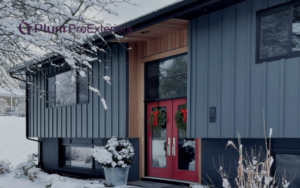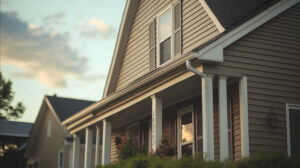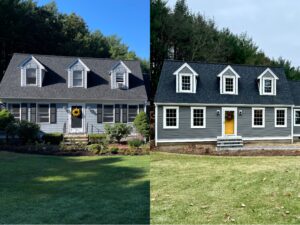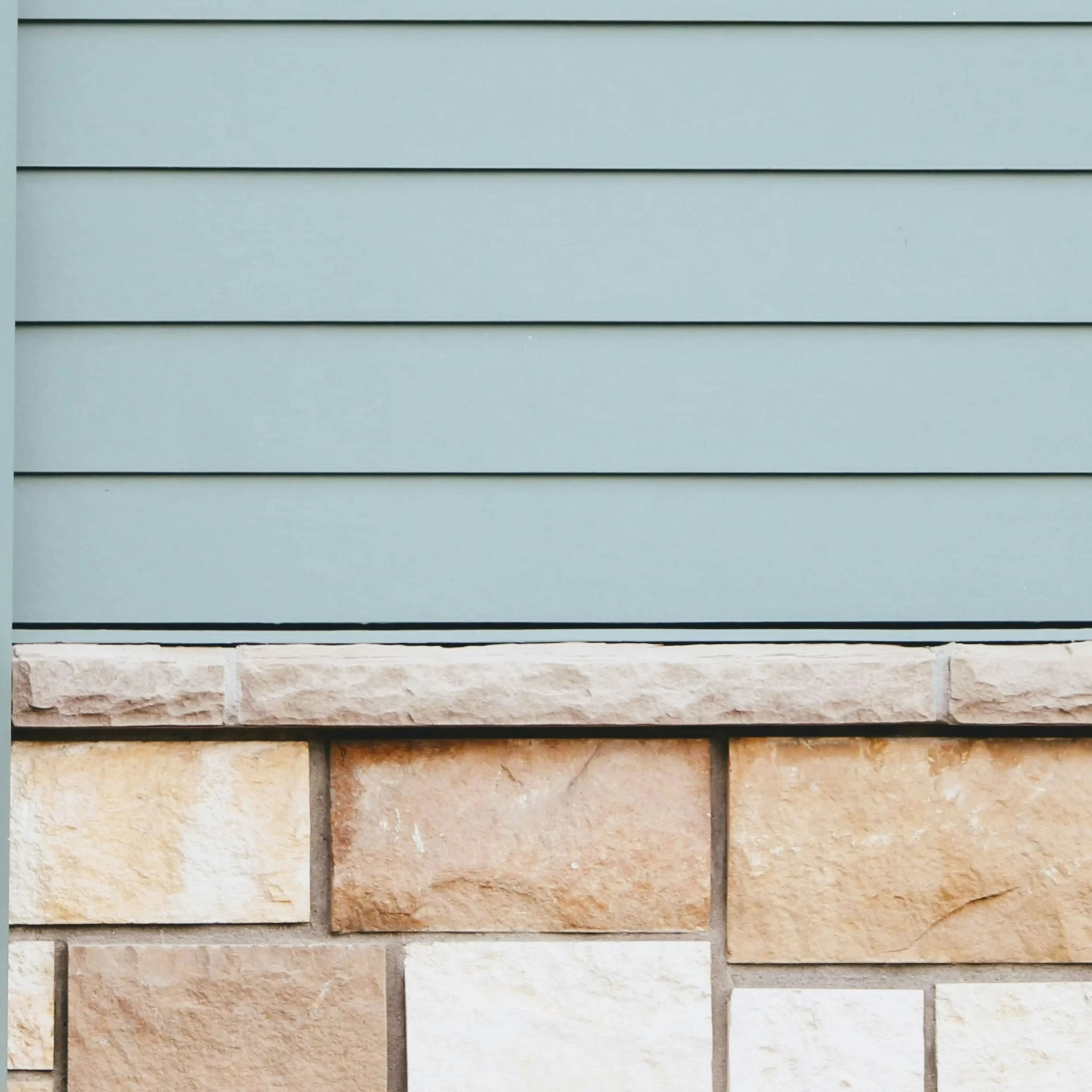

Project Manager at Plum ProExteriors
How to Choose the Best Siding for a House: The Ultimate Guide

The siding of a house is significant not only for its aesthetic contribution but also for safeguarding the property and the homeowners.
With various best house siding options available today, choosing can be overwhelming. Factors like personal preferences and budget often initiate the selection process. Fortunately, siding comes in multiple styles, colors, sizes, and cost ranges. So, every homeowner can choose the type that suits their diverse requirements. Additionally, considering trim is essential, ensuring it harmonizes with the new siding seamlessly.
Selecting the right siding enhances your house’s curb appeal and offers insulation benefits, increased comfort, and long-term protection. Popular siding types include vinyl, cedar, fiber cement, composite materials, and more.
This comprehensive guide will acquaint you with today’s full spectrum of siding options. Let’s start our research of the best siding for house!
Why is it essential to select the right type of siding material?
Recognizing the significance of selecting the best house siding material cannot be overstated. Here’s a deeper look into why this decision matters:

- Elevating visual appeal: The siding material is the outward expression of your home’s style. The siding greatly influences its overall aesthetic appeal and first impressions.
- Ensuring perfect protection: Opting for the appropriate siding material ensures robust protection for your home. This material shields it against the full spectrum of environmental elements, including rain, wind, snow, and the damaging effects of prolonged exposure to sunlight.
- Enhancing energy efficiency: Certain siding materials possess inherent insulating properties. They effectively regulate indoor temperatures and lower energy consumption. Thus, they provide a more comfortable environment for residents.
- Securing long-term investment: Choosing a durable siding material not only fortifies your home against the rigors of time and weather but also minimizes the need for frequent repairs and replacements. This will help to preserve your investment and save your budget over the years.
- Augmenting property value: Beyond immediate benefits, selecting the right siding material can significantly enhance your home’s market appeal, increasing its resale value and bolstering its standing in the real estate market.
In the article, you will discover the main factors influencing the best home siding choice. Considering them, you will ensure that your siding material aligns perfectly with your home’s needs, aesthetics, and long-term objectives.
Need the best siding solution? Turn to Plum Pro Exteriors for quality services. Contact us.
What are the popular house siding types available on the market?
If you’re exploring siding options, you’re likely considering the diverse choices available in today’s market. You’re probably also intrigued by which siding type best suits your unique home. Fortunately, the contemporary market offers many siding styles to select.
Among the many available materials, three reign supreme across most homes in the United States: vinyl, fiber cement, and wood.
While alternative options such as stone veneer merit acknowledgment, they remain less prevalent than the primary trio. The following insights aim to provide clarity amidst the multitude of choices. With our guide, you will get the answer to the question, “What is the best siding material?”.
Let’s discover the main house siding types, their benefits, and drawbacks.
Vinyl siding
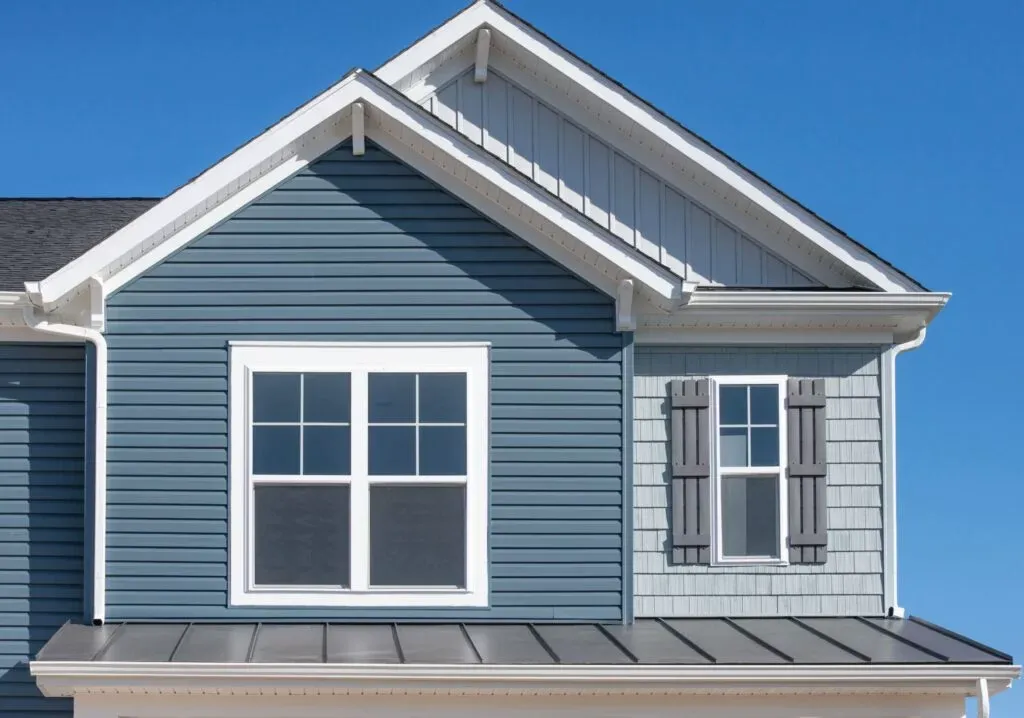
Vinyl siding emerges as a favored option among homeowners, cherished for its cost-effectiveness, adaptability, and minimal upkeep demands. Here’s a closer examination of its merits and drawbacks:
Advantages:
- Cost-effectiveness: Vinyl siding is one of the most economical choices over alternative materials, making it appealing to those mindful of their budget.
- Reasonable maintenance: One of the best qualities of vinyl siding is its low-cost maintenance nature. It requires only periodic cleaning with water and mild soap to retain its allure.
- Resilience: Vinyl siding boasts resistance against rot, pests, and moisture, rendering it a sturdy selection for diverse climates. It can withstand adverse weather conditions, comprising heavy rainfall and strong winds.
- Versatility: With an extensive array of colors, textures, and designs, vinyl siding offers homeowners ample room for customization. So, homeowners can achieve their desired visual appeal for their home’s exterior.
Disadvantages:
- Limited aesthetic variety: While vinyl siding presents numerous style options, some may find its appearance less authentic than that of natural materials like wood or stone.
- Susceptibility to damage: Over time, vinyl siding may succumb to cracking, warping, or fading, particularly in extreme weather conditions or prolonged exposure to direct sunlight. So, it needs quality painting and washing services.
- Environmental considerations: The production process of vinyl siding, derived from PVC (polyvinyl chloride), raises environmental apprehensions due to potential chemical emissions and manufacturing impacts.
- Repair challenges: Although vinyl siding is relatively straightforward to install, addressing damaged sections can pose difficulties and might require professional intervention for seamless restoration.
Despite its drawbacks, vinyl siding remains a sought-after choice for homeowners seeking the best house siding for the money. Weighing pros and cons carefully can help determine whether vinyl siding aligns with your house improvement aims.
Cost
Typically, vinyl siding materials cost between $10 and $12 per foot installed.
Wood siding

From shingles to board and batten, many genuine wood siding types exist, each imparting distinct aesthetics to homes. Wood siding varieties abound, yet they all exude that timeless, natural warmth. However, wood siding isn’t the ideal choice for budget-conscious homeowners. It is a premium option that significantly elevates material costs and entails extended installation time.
Advantages:
- Natural elegance: Wood siding radiates warmth and authenticity. Its innate grains and textures can enrich the visual look of any house.
- Versatility: From clapboards to shingles, wood siding offers various styles, empowering homeowners to tailor their exterior to their preferences.
- Customizability: Wood siding lends to painting or staining. This enables homeowners to customize their home’s facade. They can make it according to their tastes and harmonize with the general design scheme.
- Sustainability: This siding can align with eco-conscious principles through responsible sourcing, as it derives from renewable resources that can be ethically harvested and replenished.
Disadvantages:
- Elevated costs: Wood siding typically commands a higher price tag than alternatives like vinyl or fiber cement, placing it beyond the reach of budget-conscious homeowners.
- Maintenance demands: Regular upkeep, including periodic painting or staining, is essential to shield wood siding from moisture, rot, and insect damage.
- Vulnerability to damage: Wood siding is susceptible to rotting, warping, and pest infestations without adequate maintenance or prolonged exposure to prolonged moisture.
- Installation complexity: Installing wood siding can be labor-intensive and time-consuming, leading to increased installation expenses compared to other siding materials.
Wood siding exudes natural charm and offers ample design flexibility, but you should weigh its maintenance requirements and higher costs.
Cost
The cost of wood siding varies depending on the wood type utilized. Cedar siding, for instance, may cost from $26 to $32 per foot installed. Other wood options, like pine or redwood, may exhibit differing price ranges.
Fiber cement siding

Frequently known as “Hardie board” after the renowned brand James Hardie, fiber cement siding is also a popular siding option. This is owing to its exceptional durability and versatility, with options resembling authentic wood grain being particularly favored. Comprising Portland cement, sand, cellulose fibers, and water, fiber cement siding primarily incorporates various additives. These additives enhance resistance against mold, mildew, fungal growth, and pests.
Advantages:
- Exceptional durability: Fiber cement siding boasts remarkable resistance against rot, decay, and pests, ensuring homeowners’ longevity and reliability.
- Minimal upkeep: For example, unlike wood siding, fiber cement requires little maintenance, sparing homeowners from frequent repainting and enduring well against harsh weather conditions.
- Fire retardance: Fiber cement siding offers a non-combustible barrier, heightening protection against fire incidents and potentially leading to lower insurance costs.
- Versatility: With an assortment of textures and designs available, fiber cement siding offers homeowners ample flexibility to emulate the look of wood, stucco, or stone, enriching exterior design possibilities.
Disadvantages:
- Higher initial investment: The upfront cost of fiber cement siding tends to exceed that of vinyl or wood siding, posing a potential obstacle for budget-conscious homeowners.
- Installation complexity: Due to its weight and brittleness, fiber cement siding requires specialized installation techniques and tools, potentially increasing labor expenses and installation intricacies.
- Limited color palette: While fiber cement siding comes in various colors, the selection may be comparatively narrower than that of materials like vinyl, which offers virtually limitless color choices.
- Moisture vulnerability: Incorrect installation or damage to the siding may lead to moisture seepage, fostering issues such as mold or mildew growth beneath the surface.
Fiber cement siding continues to captivate homeowners seeking a robust, low-maintenance exterior solution for their residences.
Cost
The average cost of fiber cement siding materials is usually between $18 and $22 per foot installed.
Stone veneer siding
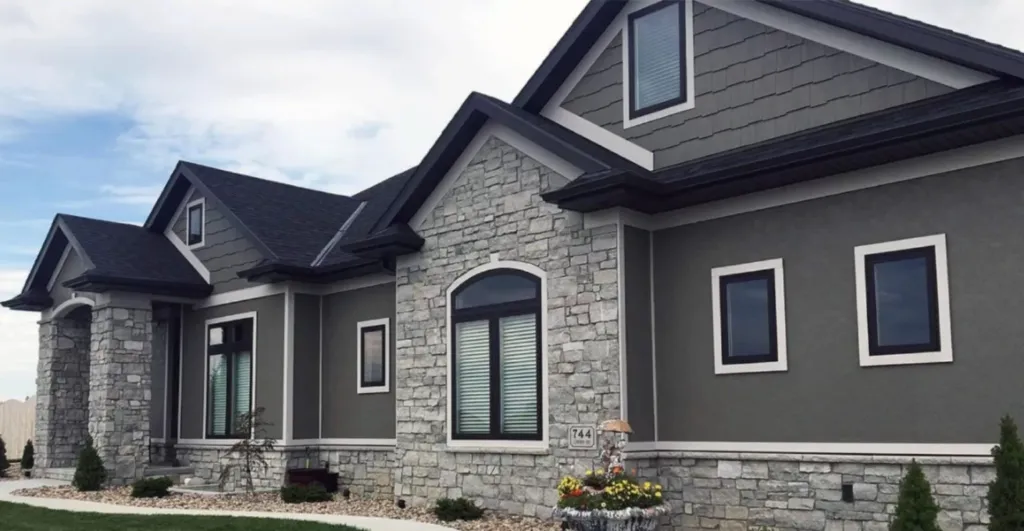
Dreaming of a stunning stone exterior for your home? While natural stone exudes timeless elegance, its installation demands hiring a skilled siding service contractor and significant material quantities. Stone veneer replicates the natural beauty of stone with a lightweight and easy-to-install solution. This durable and fade-resistant material adds a touch of rustic elegance to your home’s exterior. Unlike full stone coverage, most homeowners strategically use stone veneer to accent specific areas, creating a visually captivating focal point.
Advantages:
- Visual appeal: Stone veneer siding lends a timeless and rustic elegance to the exterior of any dwelling, enhancing its visual appeal and potentially boosting its market value.
- Robustness: Stone veneer exhibits resilience against the elements, admirably enduring inclement weather, decay, and pest infestation. Thus, it is a reliable option for long-lasting facade protection.
- Ease of upkeep: Unlike natural stone, maintaining stone veneer requires minimal effort. It can be effortlessly cleaned with a basic hose or pressure washer.
- Lightweight nature: Stone veneer boasts a lighter composition than authentic stone. This simplifies installation procedures
Disadvantages:
- Financial investment: The initial expense of stone veneer siding tends to surpass that of alternative siding materials like vinyl or fiber cement, representing a significant upfront cost for homeowners.
- More complex installation: Despite its lighter weight, stone veneer siding installation remains intricate and time-intensive, often requiring professional expertise to ensure proper adhesion and alignment.
- Maintenance challenges: While relatively low-maintenance compared to natural stone, stone veneer siding can accumulate grime, mold, and mildew over time.
- Insulation limitations: Stone veneer provides minimal insulation compared to vinyl or insulated fiber cement siding options. Supplementary insulation measures are required to improve energy efficiency.
Despite its challenges, stone veneer siding’s distinct character and lasting elegance continue to make it a favored choice among homeowners.
Cost
Stone veneer siding installation costs are priced between $74 and $76 per foot.
How to choose between house siding options?
To select the best siding for house, you need to define your aims, conduct market research, and select a reliable siding services provider that will help you to implement your vision in reality. Now, let’s consider the main stages of choosing a siding.

Assess your unique requirements
Start by analyzing your individual needs and desires regarding house siding. Consider whether complementary upgrades, like window replacement, could enhance both aesthetics and performance. Coordinating these projects can save time, reduce labor costs, and deliver a unified exterior finish.
Consider the climate zone
The weather and climate of your area are crucial factors in choosing the right siding for your home. Homes exposed to harsh weather conditions, like heavy rains or scorching sun, have different requirements than those sheltered by trees. Fiber cement siding is ideal for wet climates due to its weather resistance, while wood siding may not fare as well in moisture-heavy regions.
Research diverse siding materials
Dive into exploring the array of siding materials accessible in the market, ranging from vinyl and fiber cement to wood and stone. Read about the advantages and drawbacks of each material concerning durability, expense, maintenance demands, and visual allure.
Establish a needed budget
Define your financial boundaries for the siding endeavor and explore options that offer optimal value within your means. Consider the initial material costs and the anticipated long-term savings associated with upkeep, repairs, and energy conservation.
Seek expert consultation
Engage in consultations with seasoned contractors or siding experts to glean personalized insights and recommendations tailored to your unique circumstances. You should discuss your priorities, apprehensions, and preferences to receive specialized guidance in making the optimal siding selection.
At Plum ProExteriors, we pride ourselves on meeting all the criteria our clients seek in a siding contractor. Renowned among Southborough, MA residents, and nearby areas, we are recognized for our unwavering commitment to every project, irrespective of its scale. We always strive to deliver excellence, as evidenced by the many projects we’ve successfully undertaken. You can check our vast portfolio to make sure.
Request physical samples and visualize
Solicit tangible samples or swatches of different types of siding materials to experience their tactile qualities and visualize their visual impact firsthand. Envision how each option would integrate with your home’s surroundings, considering factors like natural lighting and landscape features.
You can also visit your siding partner’s store, if they have one, and see the materials in person.
Scrutinize warranty coverage
You should check the warranty provisions provided by manufacturers for each siding material to ensure comprehensive protection against potential defects or issues. Verify the extent, terms, and duration of warranty coverage to instill confidence and reassurance in your siding investment.
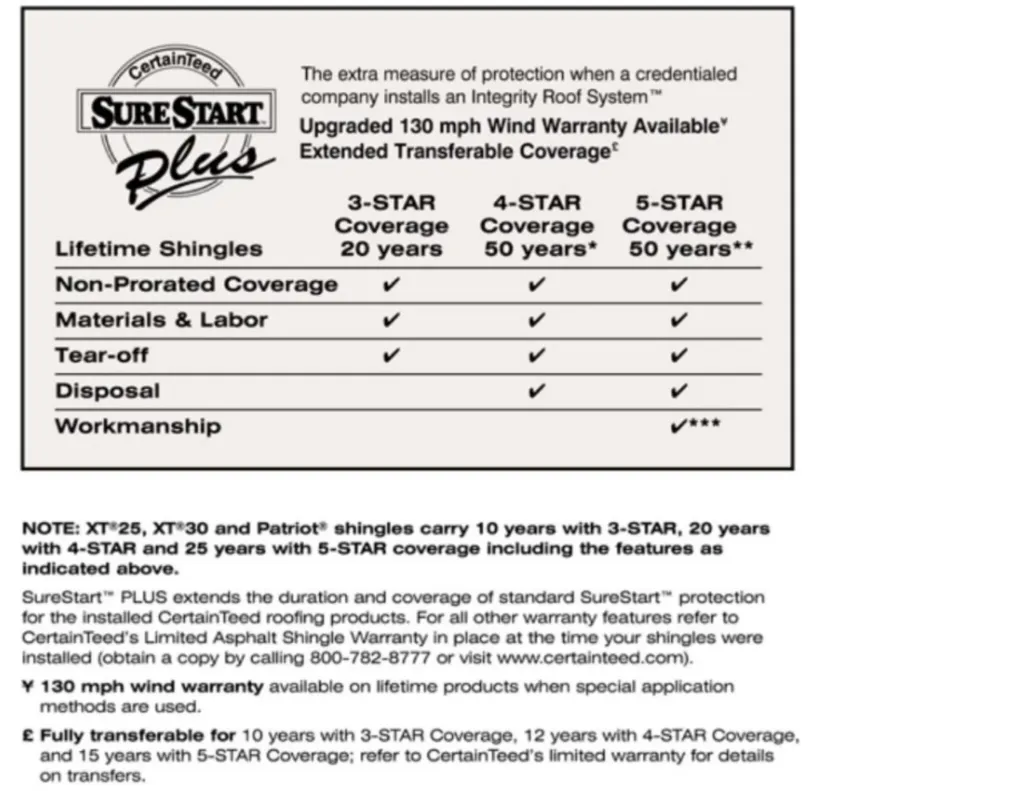
Following these steps and deliberating upon pertinent considerations, you can confidently navigate the house siding options and select the ideal choice. If you turn to a reliable siding services provider like Plum ProExteriors, you will receive a solution that perfectly aligns with your unique preferences, requirements, and budgetary considerations.
What are things to look for when choosing new house siding?
The choice of the best siding for house should be balanced and take into account many factors. Pay attention to the following points.
Budget and cost efficiency
Commence your siding selection process by thoroughly assessing your financial resources. While the initial expenses may seem quite huge, considering the long-term benefits can unveil cost-effective options.
For instance, though premium cedar types of home siding may command a higher price upfront, their exceptional durability often translates into substantial savings over time. Conversely, with its relatively lower installation costs, vinyl siding on a house may seem budget-friendly initially. However, it’s vital to consider potential maintenance and repair expenses that could accrue over the years.
Aesthetic appeal
While the functional aspects of siding are undeniably crucial, never underestimate the significance of aesthetic appeal. Your choice of siding can dramatically enhance the visual impact of your house’s look.
Take into account your residence’s architectural style and character, aiming for a seamless integration that elevates its overall aesthetics. Each siding material boasts unique visual characteristics, with certain options harmonizing more effectively with specific architectural styles than others. Consider different design solutions to perfectly balance functionality and visual allure.

Durability and longevity
When it comes to siding, prioritizing durability and longevity is paramount. Opt for materials renowned for their robustness and resilience, ensuring a worthwhile return on your investment.
Consider not only the initial installation expenses but also the long-term maintenance ones. For example, while real wood exudes timeless charm, it often necessitates regular treatments to fend off pests and withstand weather elements. Conversely, fiber cement siding stands out for its high durability and low maintenance demands. It offers a practical and long-lasting solution for homeowners seeking longevity without compromising on aesthetics.
Energy efficiency
Enhancing your home’s energy efficiency is a prudent investment that pays dividends in the long run. Selecting siding with superior insulating properties can significantly reduce utility bills while fostering a more comfortable indoor environment.
Prioritize materials with high R-value ratings, indicative of their thermal resistance capabilities. Insulated vinyl siding and cedar typically boast higher R-values than other alternatives, providing effective insulation against heat loss or gain and contributing to substantial energy savings over time.
Versatility
Flexibility and versatility are key considerations when evaluating siding options. Opt for a siding that offers a diverse range of colors, textures, shapes, and sizes to cater to your unique preferences and architectural style.
Additionally, ensure the chosen material exhibits resistance to pests and growth, bolstering its durability and longevity. Whether you prefer a traditional, rustic aesthetic or a modern, sleek finish, selecting a versatile siding material empowers you to customize your home’s exterior to reflect your personal taste and style.
Maintenance needs
Factor in the maintenance requirements of different types of siding to ensure they align with your lifestyle and preferences. While vinyl siding boasts minimal upkeep requirements, real wood may demand regular treatments and inspections to preserve its integrity and appearance.
When weighing your siding choices, consider the time, effort, and costs associated with ongoing maintenance tasks. Aim for a solution that strikes the perfect balance between aesthetics and practicality.
Ease of installation
Streamline your siding project by opting for easy-to-install materials, minimizing labor costs and project duration. Vinyl siding, renowned for its lightweight nature and straightforward installation process, presents a cost-effective and efficient solution for homeowners seeking hassle-free renovations. In contrast, heavier materials like fiber cement may require more labor-intensive installation methods, potentially leading to higher expenses and extended timelines.
Prioritize siding options that offer a seamless installation process, ensuring an efficient and smooth transition to the best exterior siding aesthetic.
Brand reputation
Choose siding materials from well-known companies with a proven track record of quality, reliability, and customer satisfaction. Investing in trusted brands backed by comprehensive warranties provides assurance of product excellence. Partnering with experienced contractors who prioritize using established brands ensures superior craftsmanship and lasting results, safeguarding your investment and enhancing your home’s value and appeal.
At Plum ProExteriors, we offer only proven materials from well-known manufacturers with warranties. Below are the main brands we use for our top-quality siding services.

- James Hardie: A leader brand in fiber cement siding and backer board technology, it has captivated clients across North America with its premier siding solutions for over a century.
- PlyGem: A prominent figure in the national siding arena that boasts a diverse portfolio featuring five distinct residential siding product lines. With an extensive palette of 37 mitten colors and ten profiles, PlyGem offers versatility to match your desired aesthetic.
- Westlake Royal: Recognized for its innovation in low-maintenance composite and vinyl siding, Westlake Royal has swiftly emerged as a trusted brand catering to diverse customer needs.
- CertainTeed: This brand stands out with its comprehensive range of low-maintenance siding products, renowned for creating enduring styles that stand the test of time.
- Everlast: It distinguishes itself with cutting-edge siding materials, featuring an impressive lineup including wood, vinyl, fiber cement, and other composite options, all meticulously crafted in-house.
- LP: This siding brand holds a prominent position among siding manufacturers, offering a wide array of options and colors tailored to complement any architectural design or motif.
Resale value
Consider the impact of your siding choice on the resale value of your home, recognizing it as a pivotal factor in maximizing your property’s marketability and appeal to potential buyers. Opting for quality siding materials installed by experienced professionals can significantly enhance your home’s curb appeal and overall value, translating into a higher return on investment when it’s time to sell.
By prioritizing durability, aesthetic appeal, quality, and other factors, you will create a more attractive and desirable living space for yourself.
Conclusion
We’ve considered all of the popular house siding types. Now you have an image of the options and the answer to the question, “What is the best siding for a house?”. So, which one looks the most suitable for your property? Knowing all the disadvantages and strengths of each, you can decide what siding is the best choice for your situation.
Our dedicated team is here to help you install or paint siding. We also provide the top siding replacement options. Contact us for the best siding services, and we will deliver the most appropriate solution to meet your unique requirements.
